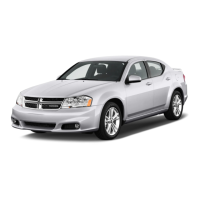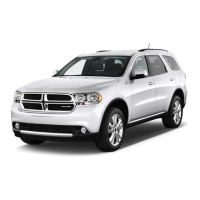Do you have a question about the Dodge avenger 2013 and is the answer not in the manual?
Guidance on navigating the manual's structure, including the table of contents and index.
Essential safety information covering warnings for injury/collision and cautions for vehicle damage.
Details on the location of the Vehicle Identification Number for reference and registration.
Warning against vehicle modifications that could compromise safety, roadworthiness, or cause injury.
Information on vehicle keys, key codes, and proper insertion into locks.
Explanation of the Sentry Key system preventing unauthorized vehicle operation.
Details on the vehicle's security alarm system, monitoring, and arming/disarming.
Operation of the RKE system for locking, unlocking, and accessing the vehicle remotely.
Comprehensive guide to seat belts, airbags, and active head restraints for passenger safety.
Covers inside and outside mirrors, including day/night, auto-dimming, power, and illuminated vanity mirrors.
Voice-activated hands-free system for phone calls, media playback, and voice commands.
Details on manual and power seat adjustments, lumbar support, and head restraints.
Guide to operating headlights, parking lights, turn signals, fog lights, and interior lighting.
Instructions for activating, setting, and using the electronic speed control system.
Programming and operation of the HomeLink® system for garage door openers.
How to operate the express and manual sunroof modes, including pinch protection.
Information on the location and usage of 12-volt power outlets in the vehicle.
Details on folding rear seats, cargo area usage, and related safety warnings.
How to operate the rear window defroster and heated mirrors.
Overview of instrument panel components with numbered labels for easy identification.
Detailed explanation of gauges, warning lights, and indicators on the instrument cluster.
Features and operation of the driver-interactive trip information and temperature display.
Guide to the driver-interactive display system for vehicle information and settings.
How to navigate through the various main menu features within the EVIC.
Instructions for displaying, calibrating, and changing compass variance.
Customizing vehicle features like language, door unlock behavior, and sound settings.
Operating instructions for the Uconnect 130 radio, including modes and controls.
Procedure for inserting and playing audio from CDs and MP3 files.
Information on supported media types, file systems, and MP3 file formats for the audio system.
Essential steps for starting the vehicle, including seat/mirror adjustment and seat belt use.
Recommendations for starting the engine in extremely cold temperatures, below -20°F (-29°C).
Troubleshooting steps for when the engine does not start, including flooded engine procedures.
Precautions for shifting gears, including warnings about damage and proper procedure.
Explanation of transmission gear ranges (PARK, REVERSE, NEUTRAL, DRIVE) and their proper usage.
How to use the AutoStick® feature for manual gear selection and improved vehicle control.
Guidelines for safe driving on snow, ice, wet, or slushy surfaces, including traction advice.
Warnings and cautions for driving in flowing or standing water to prevent damage.
Information on power steering system operation, noise, and potential issues.
Proper application, release, and function of the parking brake.
How ABS works and warnings about pumping the brakes.
Overview of ABS, TCS, BAS, and ESC systems.
How the TCS system monitors wheel spin and enhances stability.
System designed to optimize braking capability during emergency maneuvers.
Enhances directional control and stability by correcting over/under steer conditions.
Information on tire markings, identification numbers, and terminology.
Importance of proper tire pressure and safety.
Location of the tire and loading information placard.
Guidelines for determining correct load limits for tires and vehicle capacity.
Safety tips and information regarding trailer towing limits and procedures.
Definitions of towing terms like GVWR, GTW, and GAWR.
Chart of maximum trailer weight ratings based on engine and transmission.
Computing weight on the rear axle and the importance of tongue weight.
Recommendations for tire selection and maintenance when towing.
Requirements and recommendations for trailer brake systems.
Practicing towing maneuvers before a trip.
How to activate and use hazard warning flashers for emergency signaling.
Actions to take if the engine overheats, including driving tips and cooling system warnings.
Essential safety precautions and procedures for changing a tire.
Location of the spare tire and jack, and instructions for their removal.
Correct locations for jacking the vehicle and instructions for raising it safely.
Procedure for installing a road tire, including wheel covers and lug nut tightening.
Step-by-step instructions and safety precautions for jump-starting the vehicle's battery.
How to free a vehicle stuck in mud, sand, or snow using a rocking motion.
Procedure to temporarily move the shift lever if a malfunction occurs.
Procedures and precautions for towing a disabled vehicle using service.
Diagram and labels identifying key components in the 2.4L engine compartment.
Diagram and labels identifying key components in the 3.6L engine compartment.
Explanation of the OBD II system, Malfunction Indicator Light (MIL), and required emissions checks.
Information on the 'GASCAP' message and how to resolve it.
Legal requirements for vehicle emissions control system inspection and testing.
Importance of using genuine MOPAR® parts for maintenance and repairs.
Benefits of using authorized dealer service and obtaining service manuals.
Instructions for checking engine oil level, adding oil, and the oil change indicator system.
Recommendations for engine oil API certification, viscosity, and type.
Maintenance schedule and replacement procedure for the engine air cleaner filter.
Warning about removing the air induction system components and potential injury.
Information on the maintenance-free battery, its location, and handling precautions.
Recommended checks and services for the air conditioning system.
Step-by-step instructions for replacing the A/C air filter.
Lubrication points for locks, pivots, hinges, and external lock cylinders.
Instructions for cleaning and maintaining windshield wiper blades.
Procedures for cleaning instrument cluster lenses without scratching.
Guidelines for cleaning seat belts and ensuring proper function.
Location and identification of fuses within the Integrated Power Module.
Steps to preserve the vehicle's battery during storage or vacation.
List of interior and exterior bulb numbers for replacement.
Procedure for replacing headlamp bulbs.
Procedure for accessing and replacing fog lamp bulbs.
Procedure for accessing and replacing backup lamp bulbs.
Procedure for replacing license plate lamp bulbs.
Table detailing approximate fuel, engine oil, and coolant capacities in U.S. and Metric units.
Recommendations for engine oil, spark plugs, and chassis lubrication.
Tips for preparing for vehicle service appointments and making reasonable requests.
Contact information and required details for Chrysler customer assistance.
Instructions on how to report vehicle safety defects to NHTSA and the manufacturer.
Explanation of DOT tire grading categories: Treadwear, Traction, and Temperature.
Explanation of the comparative Treadwear grade based on wear rate.
Explanation of Traction grades (AA, A, B, C) for stopping on wet pavement.
Explanation of Temperature grades (A, B, C) for tire heat resistance.
Warning about heat buildup and potential tire failure due to speed, inflation, or load.
Guidance on navigating the manual's structure, including the table of contents and index.
Essential safety information covering warnings for injury/collision and cautions for vehicle damage.
Details on the location of the Vehicle Identification Number for reference and registration.
Warning against vehicle modifications that could compromise safety, roadworthiness, or cause injury.
Information on vehicle keys, key codes, and proper insertion into locks.
Explanation of the Sentry Key system preventing unauthorized vehicle operation.
Details on the vehicle's security alarm system, monitoring, and arming/disarming.
Operation of the RKE system for locking, unlocking, and accessing the vehicle remotely.
Comprehensive guide to seat belts, airbags, and active head restraints for passenger safety.
Covers inside and outside mirrors, including day/night, auto-dimming, power, and illuminated vanity mirrors.
Voice-activated hands-free system for phone calls, media playback, and voice commands.
Details on manual and power seat adjustments, lumbar support, and head restraints.
Guide to operating headlights, parking lights, turn signals, fog lights, and interior lighting.
Instructions for activating, setting, and using the electronic speed control system.
Programming and operation of the HomeLink® system for garage door openers.
How to operate the express and manual sunroof modes, including pinch protection.
Information on the location and usage of 12-volt power outlets in the vehicle.
Details on folding rear seats, cargo area usage, and related safety warnings.
How to operate the rear window defroster and heated mirrors.
Overview of instrument panel components with numbered labels for easy identification.
Detailed explanation of gauges, warning lights, and indicators on the instrument cluster.
Features and operation of the driver-interactive trip information and temperature display.
Guide to the driver-interactive display system for vehicle information and settings.
How to navigate through the various main menu features within the EVIC.
Instructions for displaying, calibrating, and changing compass variance.
Customizing vehicle features like language, door unlock behavior, and sound settings.
Operating instructions for the Uconnect 130 radio, including modes and controls.
Procedure for inserting and playing audio from CDs and MP3 files.
Information on supported media types, file systems, and MP3 file formats for the audio system.
Essential steps for starting the vehicle, including seat/mirror adjustment and seat belt use.
Recommendations for starting the engine in extremely cold temperatures, below -20°F (-29°C).
Troubleshooting steps for when the engine does not start, including flooded engine procedures.
Precautions for shifting gears, including warnings about damage and proper procedure.
Explanation of transmission gear ranges (PARK, REVERSE, NEUTRAL, DRIVE) and their proper usage.
How to use the AutoStick® feature for manual gear selection and improved vehicle control.
Guidelines for safe driving on snow, ice, wet, or slushy surfaces, including traction advice.
Warnings and cautions for driving in flowing or standing water to prevent damage.
Information on power steering system operation, noise, and potential issues.
Proper application, release, and function of the parking brake.
How ABS works and warnings about pumping the brakes.
Overview of ABS, TCS, BAS, and ESC systems.
How the TCS system monitors wheel spin and enhances stability.
System designed to optimize braking capability during emergency maneuvers.
Enhances directional control and stability by correcting over/under steer conditions.
Information on tire markings, identification numbers, and terminology.
Importance of proper tire pressure and safety.
Location of the tire and loading information placard.
Guidelines for determining correct load limits for tires and vehicle capacity.
Safety tips and information regarding trailer towing limits and procedures.
Definitions of towing terms like GVWR, GTW, and GAWR.
Chart of maximum trailer weight ratings based on engine and transmission.
Computing weight on the rear axle and the importance of tongue weight.
Recommendations for tire selection and maintenance when towing.
Requirements and recommendations for trailer brake systems.
Practicing towing maneuvers before a trip.
How to activate and use hazard warning flashers for emergency signaling.
Actions to take if the engine overheats, including driving tips and cooling system warnings.
Essential safety precautions and procedures for changing a tire.
Location of the spare tire and jack, and instructions for their removal.
Correct locations for jacking the vehicle and instructions for raising it safely.
Procedure for installing a road tire, including wheel covers and lug nut tightening.
Step-by-step instructions and safety precautions for jump-starting the vehicle's battery.
How to free a vehicle stuck in mud, sand, or snow using a rocking motion.
Procedure to temporarily move the shift lever if a malfunction occurs.
Procedures and precautions for towing a disabled vehicle using service.
Diagram and labels identifying key components in the 2.4L engine compartment.
Diagram and labels identifying key components in the 3.6L engine compartment.
Explanation of the OBD II system, Malfunction Indicator Light (MIL), and required emissions checks.
Information on the 'GASCAP' message and how to resolve it.
Legal requirements for vehicle emissions control system inspection and testing.
Importance of using genuine MOPAR® parts for maintenance and repairs.
Benefits of using authorized dealer service and obtaining service manuals.
Instructions for checking engine oil level, adding oil, and the oil change indicator system.
Recommendations for engine oil API certification, viscosity, and type.
Maintenance schedule and replacement procedure for the engine air cleaner filter.
Warning about removing the air induction system components and potential injury.
Information on the maintenance-free battery, its location, and handling precautions.
Recommended checks and services for the air conditioning system.
Step-by-step instructions for replacing the A/C air filter.
Lubrication points for locks, pivots, hinges, and external lock cylinders.
Instructions for cleaning and maintaining windshield wiper blades.
Procedures for cleaning instrument cluster lenses without scratching.
Guidelines for cleaning seat belts and ensuring proper function.
Location and identification of fuses within the Integrated Power Module.
Steps to preserve the vehicle's battery during storage or vacation.
List of interior and exterior bulb numbers for replacement.
Procedure for replacing headlamp bulbs.
Procedure for accessing and replacing fog lamp bulbs.
Procedure for accessing and replacing backup lamp bulbs.
Procedure for replacing license plate lamp bulbs.
Table detailing approximate fuel, engine oil, and coolant capacities in U.S. and Metric units.
Recommendations for engine oil, spark plugs, and chassis lubrication.
Tips for preparing for vehicle service appointments and making reasonable requests.
Contact information and required details for Chrysler customer assistance.
Instructions on how to report vehicle safety defects to NHTSA and the manufacturer.
Explanation of DOT tire grading categories: Treadwear, Traction, and Temperature.
Explanation of the comparative Treadwear grade based on wear rate.
Explanation of Traction grades (AA, A, B, C) for stopping on wet pavement.
Explanation of Temperature grades (A, B, C) for tire heat resistance.
Warning about heat buildup and potential tire failure due to speed, inflation, or load.
| Brand | Dodge |
|---|---|
| Model | avenger 2013 |
| Category | Automobile |
| Language | English |












